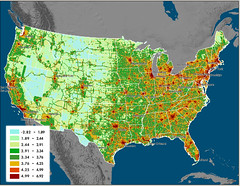How is the United States doing in its quest to tread more lightly on the environment? It’s not a simple question – so no simple answer – but we are making progress. It’s important to recognize the gains made by those of us who take the challenge seriously.
And it’s nice to have good news on occasion.
Take, for example, efforts to limit greenhouse gas (GHG) emissions. According to the U.S. Energy Information Administration’s (EIA) February 2011 Monthly Energy Review, CO2 emissions are decreasing.
The Kyoto Protocol, adopted in 1997, sought to establish a binding agreement among developed nations to reduce GHG emissions. The U.S., of course, hasn’t signed it, but we were involved in crafting it. The non-binding (since we didn’t sign) target for the U.S. is to reduce emissions 7% below 1990 levels by the year 2012. This is harder than it sounds because by 1997 our CO2 emission levels were already about 10% higher than the 1990 levels. This, before we even began. And by 2005, when the Kyoto Protocol was ratified and went into force, our residential CO2 emissions were at their all-time peak.
How have we done since then?
Well, we aren’t there yet – in fact we aren’t back down to 1990 levels, much less a reduction of 7%.
But what is encouraging is that the trend of rising emissions is flattening, and even declining. 2009 residential CO2 emission levels were the lowest since 1999, and were down nearly 8% from the peak reached in 2005. 2010 levels are up a little, but still down about 3% from 2005.
Something’s obviously working. Improvements like these don’t happen automatically – especially when you consider the sharp increase we’ve seen in the number of appliances in the average home.
There’s work to be done, but there’s also progress, and that’s something to applaud. Let’s keep up our efforts toward energy efficiency and decreased GHG emissions – they’re doing some good.







Leave A Comment